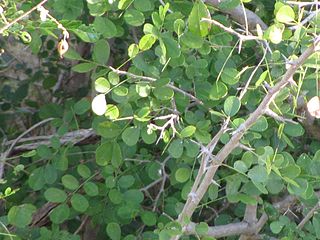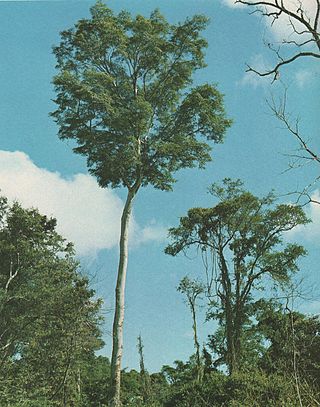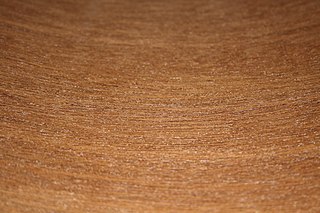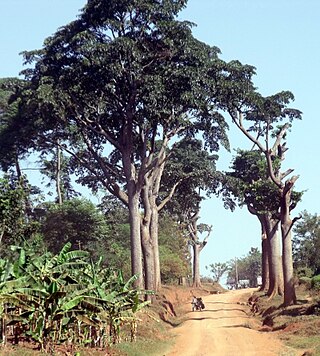
Ceiba pentandra is a tropical tree of the order Malvales and the family Malvaceae, native to Mexico, Central America and the Caribbean, northern South America, and West Africa. A somewhat smaller variety was introduced to South and Southeast Asia, where it is cultivated.

Herring are forage fish, mostly belonging to the family of Clupeidae.

Dalbergia melanoxylon is a flowering plant in the family Fabaceae, native to seasonally dry regions of Africa from Senegal east to Eritrea and south to the north-eastern parts of South Africa. The tree is an important timber species in its native areas; it is used in the manufacture of musical instruments and fine furniture. Populations and genomic resources for genetic biodiversity maintenance in parts of its native range are threatened by overharvesting due to poor or absent conservation planning and by the species' low germination rates.

Allocasuarina torulosa, the rose she-oak or forest oak or rose them-oak or rose they-oak, is a tree which grows in sub-rainforest of Queensland and New South Wales, Australia. There, it is typically found on coastal footslopes, hills, and plains. Originally described as Casuarina torulosa by William Aiton, it was moved to its current genus in 1982 by Australian botanist Lawrie Johnson. It is the type species of the genus Allocasuarina.

Intsia bijuga, commonly known as Borneo teak, Johnstone River teak, Kwila, Moluccan ironwood, Pacific teak, scrub mahogany and vesi, is a species of flowering tree in the family Fabaceae, native to the Indo-Pacific. It ranges from Tanzania and Madagascar east through India and Queensland, Australia, Papua New Guinea to the Pacific islands of Fiji and Samoa. It grows to around 50 metres tall with a highly buttressed trunk. It inhabits mangrove forests. Intsia bijuga differ from Intsia palembanica in the number of leaflets that make up their compound leaves.

Quercus faginea, the Portuguese oak, is a species of oak native to the western Mediterranean region in the Iberian Peninsula. Similar trees in the Atlas Mountains of northwest Africa are usually included in this species, or sometimes treated as a distinct species, Quercus tlemcenensis. It occurs in mountains from sea level to 1,900 metres above sea level, and flourishes in a variety of soils and climates. Out of all the oak forests in the Iberian Peninsula, the southern populations of Portuguese oak were found to have the highest diversity and endemism of spider species.
Signed into law June 28, 2005, and effective August 8, 2005, Louisiana State Act No 159 found in, Louisiana RS 40:989.1, outlawed the cultivation, possession or sale of 40 named plants defined as hallucinogenic in the state of Louisiana, US. House Bill 173 of 2010 further restricted the sale and possession of herbs in the state. However, use of the plants "strictly for aesthetic, landscaping, or decorative purposes" was allowed. The list contained as many as thirty legitimate herbs of commerce which had no hallucinogenic properties. The law was amended in 2015 to allow certain herbs that had been banned by the state to again be sold in dietary supplement products.

Agathis dammara, commonly known as the Amboina pine or dammar pine, is a coniferous timber tree native to Sulawesi, the Maluku Islands and the Philippines.

Amburana cearensis is a species of timber tree in the family Fabaceae. This plant is native to Argentina, Bolivia, Brazil, Paraguay, and Peru. It is threatened by habitat loss.

Libocedrus bidwillii, also called pāhautea, kaikawaka or New Zealand cedar, is a species of Libocedrus, endemic to New Zealand. It is in the cypress family Cupressaceae.
Axinaea sclerophylla is a species of tree in the family Melastomataceae. It is endemic to Ecuador, where its natural habitat is subtropical or tropical moist montane forests.
Ilex sclerophylla is a species of plant in the family Aquifoliaceae. It is a tree endemic to Peninsular Malaysia.

Khaya senegalensis is a species of tree in the Meliaceae family that is native to Africa. Common names include African mahogany, dry zone mahogany, Gambia mahogany, khaya wood, Senegal mahogany, cailcedrat, acajou, djalla, and bois rouge.

Kapur is a dipterocarp hardwood from trees of the genus Dryobalanops found in lowland tropical rainforests of Malaysia, Indonesia and South-East Asia. It is a durable construction tropical timber. One variety, D. aromatica, is a source of camphor.

Kogelberg Sandstone Fynbos is a critically endangered vegetation type occurring in the far south of the Western Cape, South Africa.

Iroko is a large hardwood tree from the west coast of tropical Africa that can live up to 500 years. This is the common name for the genus Milicia, in which there are two recognized species, which are closely related: Milicia excelsa and Milicia regia.

Deforestation in Papua New Guinea has been extensive and in recent decades from 2001 to 2020, Papua New Guinea lost 1.57Mha of tree cover, equivalent to a 3.7% decrease in tree cover since 2000, and 1.15Gt of CO₂e emissions.

Dipterocarpus hispidus is a species of tree in the family Dipterocarpaceae, endemic to Sri Lanka.
Maquira is a genus of trees in the family Moraceae, native to South America.















